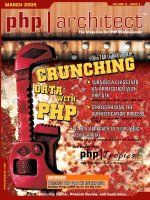Tài liệu Industry’s First QoSEnhanced MPLS TE Solution docx
Bạn đang xem bản rút gọn của tài liệu. Xem và tải ngay bản đầy đủ của tài liệu tại đây (2.88 MB, 35 trang )
1
© 2001, Cisco Systems, Inc.
Industry’s First QoS
Industry’s First QoS
-
-
Enhanced MPLS TE
Enhanced MPLS TE
Solution
Solution
Azhar Sayeed
Azhar Sayeed
Manager, IOS Product Management,
Manager, IOS Product Management,
Contact Info: Kim Gibbons,
Contact Info: Kim Gibbons,
, 408
, 408
-
-
525
525
-
-
4909
4909
2
© 2001, Cisco Systems, Inc.
Agenda
Agenda
• MPLS Traffic Engineering (TE)
Technology and Applications
• Why Extend QoS into MPLS TE
• Guaranteed Bandwidth Services
QoS-enhanced MPLS Traffic Engineering
• The Cisco IOS Advantage
• Summary, Comments & Questions
3
© 2001, Cisco Systems, Inc.
MPLS Is The Key Technology for
MPLS Is The Key Technology for
IP Service Delivery
IP Service Delivery
IP+ATM Switch
IP+ATM Switch
PNNI
PNNI
MPLS
MPLS
IP
IP
IP+ATM—MPLS Brings IP and ATM Together
IP+ATM—MPLS Brings IP and ATM Together
Network-Based VPNs with MPLS—A Foundation
for Value Added Service Delivery
Network-Based VPNs with MPLS—A Foundation
for Value Added Service Delivery
• Flexible user and service grouping (biz-to-biz)
• Flexibility of IP and the QoS of ATM
• Enables application and content hosting inside each VPN
• Transport independent
• Low provisioning costs enable affordable managed services
• Flexible user and service grouping (biz-to-biz)
• Flexibility of IP and the QoS of ATM
• Enables application and content hosting inside each VPN
• Transport independent
• Low provisioning costs enable affordable managed services
• Eliminates IP “over” ATM overhead and complexity
• One network for Internet, business IP VPNs, and transport
• Eliminates IP “over” ATM overhead and complexity
• One network for Internet, business IP VPNs, and transport
ATM
Services
ATM
Services
IP
Services
IP
Services
4
© 2001, Cisco Systems, Inc.
Key Messages
Key Messages
• DiffServ-aware MPLS TE: A powerful
solution for improving network resource
management
• Guaranteed Bandwidth Services:
Assuring value-added services
Better availability with TE, scalable
VPN solution
• Cisco: Leading the industry and market
with advanced, integrated MPLS and QoS
solutions
5
© 2001, Cisco Systems, Inc.
What is MPLS Traffic Engineering?
What is MPLS Traffic Engineering?
• Process of routing data traffic in
order to balance the traffic load on
the various links, routers, and
switches in the network
• Key in most networks where multiple
parallel or alternate paths are
available
6
© 2001, Cisco Systems, Inc.
Why Traffic Engineering?
Why Traffic Engineering?
• Congestion in the network due to changing traffic patterns
Election news, online trading, major sports events
• Better utilization of available bandwidth
Route on the non-shortest path
• Route around failed links/nodes
Fast rerouting around failures, transparently to users
Like SONET APS (Automatic Protection Switching)
• Virtual IP leased line services
VoIP Toll-Bypass applications, point-to-point bandwidth guarantees
• Capacity planning
TE improves aggregate availability of the network
7
© 2001, Cisco Systems, Inc.
R8
R2
R6
R3
R4
R7
R5
R1
IP (Mostly) Uses Destination-Based Least-Cost Routing
Flows from R8 and R1 Merge at R2 and Become Indistinguishable
From R2, Traffic to R3, R4, R5 Use Upper Route
IP (Mostly) Uses Destination-Based Least-Cost Routing
Flows from R8 and R1 Merge at R2 and Become Indistinguishable
From R2, Traffic to R3, R4, R5 Use Upper Route
Alternate Path Under-Utilized
Alternate Path Under-Utilized
IP Routing and The Fish
IP Routing and The Fish
8
© 2001, Cisco Systems, Inc.
MPLS TE Application
MPLS TE Application
• Protection solution
Similar to SONET’s automatic protection switching
• Fast re-route
Goal is to match SONET restoral times—50 ms
Locally patch around lost facilities
Locally re-route around failed links/nodes
Strategies
Alternate tunnel (1->1 mapping) or
tunnel within tunnel (n->1 mapping)
How is this done?
Locally re-route traffic onto backup paths when informed
by lower layers (SONET etc.)
The backup paths are pre-established—however,
bandwidth needn’t be double counted
9
© 2001, Cisco Systems, Inc.
Node and Link Protection
Node and Link Protection
R8
R2
R6
R3
R4
R7
R1 R5
R9
• Multiple hops can be by-passed. R2 swaps the label which R4
expects before pushing the label for R6
• R2 locally patches traffic onto the link with R6
• Multiple hops can be by-passed. R2 swaps the label which R4
expects before pushing the label for R6
• R2 locally patches traffic onto the link with R6
10
© 2001, Cisco Systems, Inc.
Cisco MPLS AutoBandwidth
Cisco MPLS AutoBandwidth
• Automatically increases or decreases bandwidth reserved for an
MPLS TE tunnel based on measured traffic load
Tunnels are resized within a specified range based on actual traffic rates
over time. Both time interval and bandwidth range are configurable.
• Makes it easy to configure and monitor bandwidth for MPLS TE
tunnels
• Automatically increases or decreases bandwidth reserved for an
MPLS TE tunnel based on measured traffic load
Tunnels are resized within a specified range based on actual traffic rates
over time. Both time interval and bandwidth range are configurable.
• Makes it easy to configure and monitor bandwidth for MPLS TE
tunnels
Cisco
Cisco
-
-
unique feature!
unique feature!
Minimum
Maximum
Total
bandwidth
for all TE
tunnels
on a path
Bandwidth reserved for
a TE tunnel using Cisco
AutoBandwidth allocator
Bandwidth
available to
other tunnels
Tunnel
resized to
traffic rate
Time
11
© 2001, Cisco Systems, Inc.
End
End
-
-
to
to
-
-
End Solution
End Solution
via Cisco IOS
via Cisco IOS
®
®
Software
Software
5 Mbps
5 Mbps
1 Mbps
1 Mbps
HQ1
VPN HQ
Back-up
VPN and Traffic Engineering Combined
to Provide End-to-End Services
VPN and Traffic Engineering Combined
to Provide End-to-End Services
MPLS VPN
MPLS TE
MPLS TE
12
© 2001, Cisco Systems, Inc.
DiffServ
DiffServ
Industry Standard
Industry Standard
Differentiated Services
Differentiated Services
13
© 2001, Cisco Systems, Inc.
No state
Best Effort
Per-flow state
IntServ / RSVP
Aggregated
state
DiffServ
1. The original IP service
2. First efforts at IP QoS
3. Seeking simplicity and scale
Time
4. Bandwidth Optimization & End-to-End SLAs
(IntServ+DiffServ+ Traffic Engineering)
The IP QoS Pendulum
The IP QoS Pendulum
14
© 2001, Cisco Systems, Inc.
PROVISIONING & MONITORING
PROVISIONING & MONITORING
VPNs
VPNs
Multimedia
Video Conferencing
Collaboration
Multimedia
Video Conferencing
Collaboration
Mission
Critical
Mission
Critical
VoIP
VoIP
Hybrid
Hybrid
MPLS
MPLS
DiffServ
DiffServ
IntServ
IntServ
Signaling Techniques (RSVP, DSCP, ATM (UNI/NNI))
Signaling Techniques (RSVP, DSCP, ATM (UNI/NNI))
Link Efficiency Mechanisms (Compression, Fragmentation)
Link Efficiency Mechanisms (Compression, Fragmentation)
Congestion Avoidance Techniques (WRED)
Congestion Avoidance Techniques (WRED)
Congestion Management Techniques (PQ, WFQ, LLQ)
Congestion Management Techniques (PQ, WFQ, LLQ)
Classification & Marking Techniques (DSCP, IP Precedence, NBAR, etc.)
Classification & Marking Techniques (DSCP, IP Precedence, NBAR, etc.)
Frame
Relay
Frame
Relay
PPP
HDLC
PPP
HDLC SDLC
SDLC
ATM, POS
ATM, POS FE,Gig.E
10GE
FE,Gig.E
10GE
Wireless
Fixed,Mobile
Wireless
Fixed,Mobile
BroadBand
Cable,xDSL
BroadBand
Cable,xDSL
POLICY-BASED NETWORKING
POLICY-BASED NETWORKING
Traffic Conditioners (Policing, Shaping)
Traffic Conditioners (Policing, Shaping)
The Cisco QoS Framework
The Cisco QoS Framework









